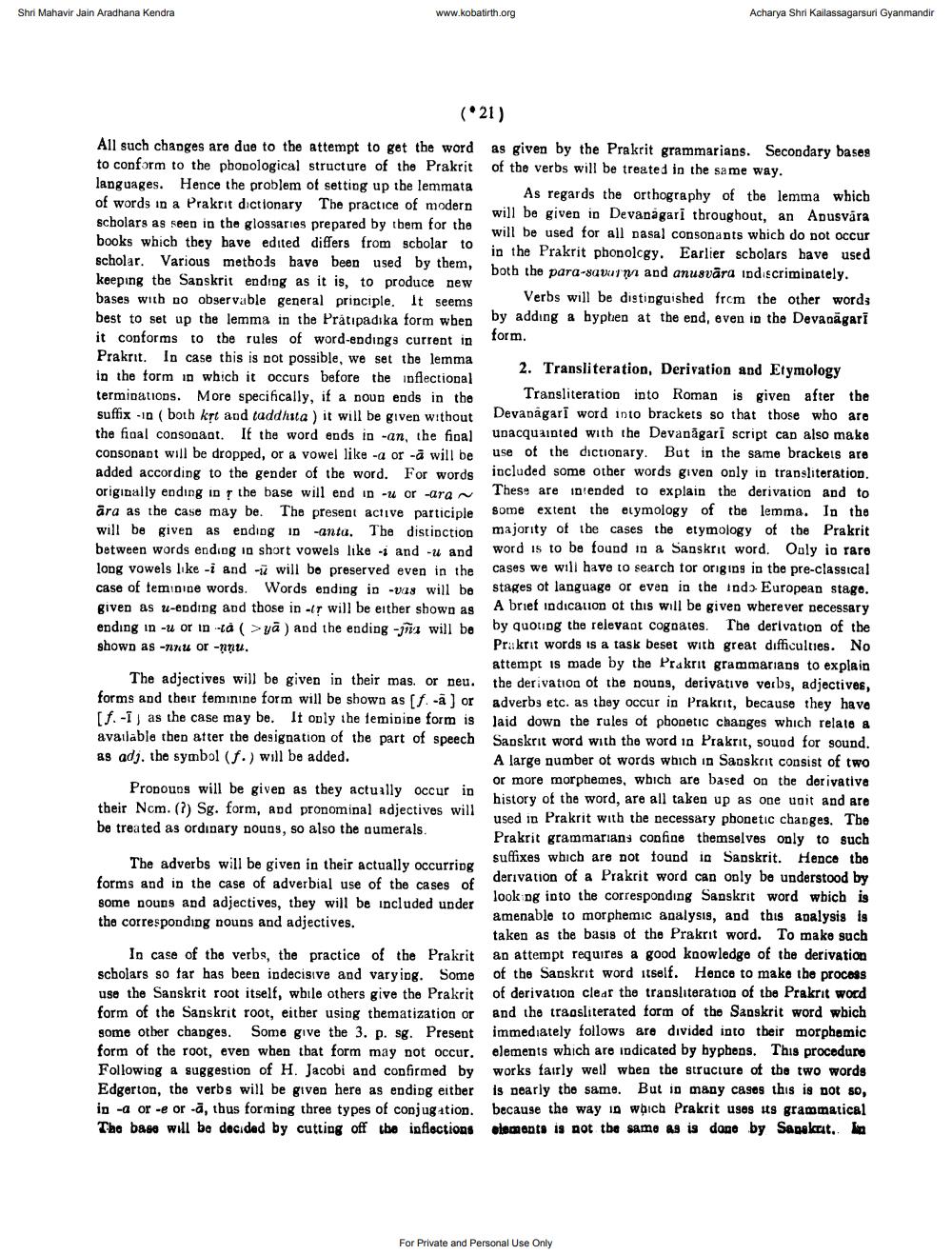________________
Shri Mahavir Jain Aradhana Kendra
www.kobatirth.org
(21)
as given by the Prakrit grammarians. Secondary bases of the verbs will be treated in the same way.
All such changes are due to the attempt to get the word to conform to the phonological structure of the Prakrit languages. Hence the problem of setting up the lemmata of words in a Prakrit dictionary The practice of modern scholars as seen in the glossaries prepared by them for the books which they have edited differs from scholar to scholar. Various methods have been used by them, keeping the Sanskrit ending as it is, to produce new bases with no observable general principle. It seems best to set up the lemma in the Pratipadika form when it conforms to the rules of word-endings current in Prakrit. In case this is not possible, we set the lemma in the form in which it occurs before the inflectional terminations. More specifically, if a noun ends in the suffix -in (both kṛt and taddhita) it will be given without the final consonant. If the word ends in -an, the final consonant will be dropped, or a vowel like a or a will be added according to the gender of the word. For words originally ending in the base will end in -u or -ara~ ara as the case may be. The present active participle will be given as ending in -anta. The distinction between words ending in short vowels like i and -u and long vowels like -i and - will be preserved even in the case of teminine words. Words ending in -vas will be given as u-ending and those in -tr will be either shown as ending in -u or in-ta (>ya) and the ending -1 will be shown as -nnu or -nnu.
The adjectives will be given in their mas. or neu. forms and their feminine form will be shown as [f. -a] or [f. I as the case may be. It only the feminine form is available then atter the designation of the part of speech as adj. the symbol (f.) will be added.
Pronouns will be given as they actually occur in their Ncm. (?) Sg. form, and pronominal adjectives will be treated as ordinary nouns, so also the numerals.
The adverbs will be given in their actually occurring forms and in the case of adverbial use of the cases of some nouns and adjectives, they will be included under the corresponding nouns and adjectives.
In case of the verbs, the practice of the Prakrit scholars so far has been indecisive and varying. Some use the Sanskrit root itself, while others give the Prakrit form of the Sanskrit root, either using thematization or some other changes. Some give the 3. p. sg. Present form of the root, even when that form may not occur. Following a suggestion of H. Jacobi and confirmed by Edgerton, the verbs will be given here as ending either in -a or -e or -a, thus forming three types of conjugation. The base will be decided by cutting off the inflections
Acharya Shri Kailassagarsuri Gyanmandir
will be given in Devanagari throughout, an Anusvāra As regards the orthography of the lemma which will be used for all nasal consonants which do not occur
in the Prakrit phonology. Earlier scholars have used both the para-savarna and anusvāra indiscriminately.
Verbs will be distinguished from the other words by adding a hyphen at the end, even in the Devanagarī form.
2. Transliteration, Derivation and Etymology
Transliteration into Roman is given after the Devanagari word into brackets so that those who are unacquainted with the Devanagari script can also make use of the dictionary. But in the same brackets are included some other words given only in transliteration. These are intended to explain the derivation and to some extent the etymology of the lemma. In the majority of the cases the etymology of the Prakrit word is to be found in a Sanskrit word. Only in rare. cases we will have to search for origins in the pre-classical stages of language or even in the indo European stage. A brief indication of this will be given wherever necessary by quoting the relevant cognates. The derivation of the Prakrit words is a task beset with great difficulties. No attempt is made by the Prakrit grammarians to explain the derivation of the nouns, derivative verbs, adjectives, adverbs etc. as they occur in Prakrit, because they have laid down the rules of phonetic changes which relate a Sanskrit word with the word in Prakrit, sound for sound. A large number of words which in Sanskrit consist of two or more morphemes, which are based on the derivative history of the word, are all taken up as one unit and are used in Prakrit with the necessary phonetic changes. The Prakrit grammarians confine themselves only to such
suffixes which are not found in Sanskrit. Hence the derivation of a Prakrit word can only be understood by look ng into the corresponding Sanskrit word which is amenable to morphemic analysis, and this analysis is taken as the basis of the Prakrit word. To make such an attempt requires a good knowledge of the derivation of the Sanskrit word itself. Hence to make the process of derivation clear the transliteration of the Prakrit word and the transliterated form of the Sanskrit word which immediately follows are divided into their morphemic elements which are indicated by hyphens. This procedure works fairly well when the structure of the two words is nearly the same. But in many cases this is not so, because the way in which Prakrit uses its grammatical elements is not the same as is done by Sanskrit. In
For Private and Personal Use Only




